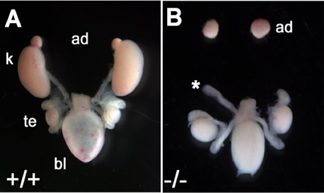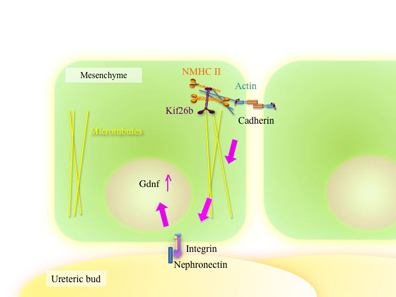
Yukako Uchiyama*, Masaji Sakaguchi*, Takeshi Terabayashi, Toshiaki Inenaga, Shuji Inoue, Chiyoko Kobayashi, Naoko Oshima, Hiroshi Kiyonari, Naomi Nakagata, Yuya Sato, Kiyotoshi Sekiguchi, Hiroaki Miki, Eiichi Araki, Sayoko Fujimura, Satomi S. Tanaka, and Ryuichi Nishinakamura (2010) Kif26b, a kinesin family gene, regulates adhesion of the embryonic kidney mesenchyme. Proc. Natl. Acad. Sci. USA, published on line: May 3, 2010 doi:10.1073/pnas.0913748107 (* equal contribution )
The kidney develops through reciprocal interactions between two precursor tissues: the metanephric mesenchyme and the ureteric bud. We previously demonstrated that the zinc finger protein Sall1 is essential for ureteric bud attraction toward the mesenchyme. Here we show that Kif26b , a kinesin family gene, is a downstream target of Sall1 and that disruption of this gene causes kidney agenesis because of impaired ureteric bud attraction. In the Kif26b -null metanephros, compact adhesion between mesenchymal cells adjacent to the ureteric buds and the polarized distribution of integrin α8 were impaired, resulting in failed maintenance ofGdnf , a critical ureteric bud attractant. Overexpression of Kif26b in vitrocaused increased cell adhesion through interactions with non-muscle myosin. Thus Kif26b is essential for kidney development because it regulates the adhesion of mesenchymal cells in contact with ureteric buds. To the best of our knowledge, this is the first report that a kinesin deficiency can cause the lack of an entire organ.

Fig. 1. Kidney agenesis in Kif26b -null mutants.
Urogenital tissues from wild-type (A) and Kif26b -null (B) newborn mice. ad, adrenal gland; k, kidney; te, testis; bl, bladder. Asterisk, blind-ended ureter.

Fig. 2 Molecular functions of Kif26b in the embryonic kidney
Kif26b plays an important role in the compact adhesion between mesenchymal cells adjacent to the ureteric buds, possibly by interacting with non-muscle myosin (NMHCII). This could lead to the establishment of the basolateral integrity of the mesenchyme and the polarized expression of integrin α8, which maintains the Gdnf expression required for further ureteric bud attraction.